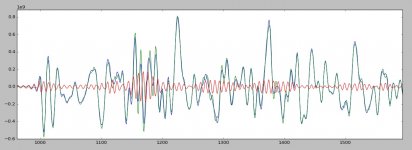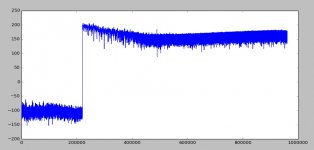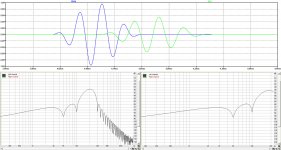Wouldn't it just be easier to just subtract the blue and green and show the difference on a plot of the same timeframe?
Here the difference (red) seems to be mostly at the Gibbs frequency, probably a whole new can of worms.
Attachments
By audible I thought you meant you could hear it, which implies listening.When I said audible, I mean of the same waveform shape of the blue, and am simply considering the blue waveform to be all audible content.
edit: in re-reading...I said "audible content", that should be self explanatory.
If you examine the two waveforms scott put up, the unfiltered green on occasion has roughly 20% higher peaks than the blue filtered, but they are of the same form. If the difference is of the same shape of the blue in time, then it is a simple reduction in envelope.
I am not referencing the criteria of audibility by threshold nor by listening tests.
If the difference is just a fraction of the blue and of the same waveshape, it would be a smoking gun saying that the upper sideband removal also altered the audible waveform coming out of the filter.
jn
Those wave forms are inconsistent. The first few cycles match very closely, once the dc offset is gone. Then in the middle with aproximatley the same freq. and amplitude they are out 20%. Whats with that.
I would really want to discuss of this with you (but it is not the right place).Theres so much energy below 10khz ( all the way down to 30hz) that the stuff over 20khz, thats 30db down is not only inaudable because its above 20 khz but its also 30db down.
Just that I often took the cymbals in line from their slice (side) where the basses are shorted like do a speaker on a single plank. With a bidirectional or hypercardioid mic (to reject as much as possible the rest of the kit) and, sometimes, the help of a noise gate.
I don't fully agree with you about the inutility of the contents above 15kHz (15 kHz to stay polite and do not start a war ;-).
Using higher sample rates adds (to my years) a little more impact, and, curiously, less annoying treble (tiresome). Do not sound brighter, but, on the contrary, smoother and more natural.
RNM and I advocate for CFAs (high slew rate) for the same subjective reasons.
This said, apart on some Jazz recording and such, cymbals are not so important than kick drums, snare and charleston. Just a little cherry on the cake or a dot at the end of a phrase.
Well, a BIG cherry when the greasers comes in ;-) (attachment)
BTW: My best drums recording was done in a big (empty) night club that we used as a recording studio. From distance, with a pair of condenser mikes in ORTF stereo configuration. The close usual mikes,only used to add small touches of impact and precision.
A very sad memory, because, it sounded amazing in the control room, until I had trouble with my friend the singer, for personal and sad human reasons. He made the mix with another sound engineer in another studio, and they don't called-me to get details about the multitrack. Nothing was precised, because I was supposed to make the mix.
The guy had mixed the usual way, complaining about the leakages on what he believed to be the cymbals tracks. Put a noise gate on it, and ruined everything.
YouTube
Damn, my job makes me miss
Last edited:
Except it explains it?Here the difference (red) seems to be mostly at the Gibbs frequency, probably a whole new can of worms.
Here's the spectrum of the difference. Scale is arbitrary on the vertical and frequency x10 on the horizontal (10 sec of data). Notice the brickwall is perfect a transition in one bin (0.1Hz) of -300dB. Why the time domain looks like mostly 22050Hz is a mystery to me.
EDIT - Looking at the scale the energy near 22050 is 50dB more than the higher frequency information so maybe not a mystery.
EDIT - Looking at the scale the energy near 22050 is 50dB more than the higher frequency information so maybe not a mystery.
Attachments
Last edited:
@Markw4 - This is the schematic of the fix for the ESS hump, the plots are impressive.
How to Fix ESS Hump on SGD1 and LA-QXD1 | Audio Science Review (ASR) Forum
How to Fix ESS Hump on SGD1 and LA-QXD1 | Audio Science Review (ASR) Forum
Here the difference (red) seems to be mostly at the Gibbs frequency, probably a whole new can of worms.
Now that, I did not see coming.
That is going to take some thinking..
hmmm. We see gibbs when the slew rate exceeds bandwidth ala square wave transitions.. The filter reacting so to speak to a call to do more than it will allow..
The Gibbs envelope seems to correlate to the hf content of the green unfiltered, and almost seems to correlate to a phase shift between filtered and non filtered. In fact, when there's lots of gibbs energy, the amplitude of the blue filtered is diminished.
Thanks for the effort, I will be thinking about this for a while.
Did you get a chance to try a 5k/20k modulation envelope or simple gated 20K through the same process? At least there, we're dealing with a bit more known.
jn
Last edited:
And i wonder if the original was 176.4k sampled ( an even multiple of 44.1k) if you would get a different (better) result.
...the fix for the ESS hump, the plots are impressive...
Thank you. Indeed impressive. The strange thing is that it is not the only fix. No one seems to know why one fix works in one dac and another fix in another dac. Its not always just different R and C values either.
Oh, well. AK4499 is another story, and a happier one I think/hope. They seem to have gone all out to get market share back from ESS. Don't know to what extent it might accomplish that, though.
Last edited:
Scott,Here's the spectrum of the difference. Scale is arbitrary on the vertical and frequency x10 on the horizontal (10 sec of data). Notice the brickwall is perfect a transition in one bin (0.1Hz) of -300dB. Why the time domain looks like mostly 22050Hz is a mystery to me.
EDIT - Looking at the scale the energy near 22050 is 50dB more than the higher frequency information so maybe not a mystery.
Could you show the inverse transform of your brick-wall.
Hans
Here's the spectrum of the difference. Scale is arbitrary on the vertical and frequency x10 on the horizontal (10 sec of data). Notice the brickwall is perfect a transition in one bin (0.1Hz) of -300dB. Why the time domain looks like mostly 22050Hz is a mystery to me.
EDIT - Looking at the scale the energy near 22050 is 50dB more than the higher frequency information so maybe not a mystery.
Well, the only tool in the toolbox for the brickwall is the sinc, no?
I am thinking the gibbs envelope reflects the system fighting everything that exceeds the cutoff, so by reading the envelope, we can see where the content would want to break nyquist.
To violate nyquist, we simply have to provide a stimulus that exceeds it. Frequency is one, envelope modulation by AM is a second, and I believe FM is also another way to break the bank.
If you gated a 20K sine on/off, I would think the gibbs envelope would be large at the transitions, tapering off at constant sine.
If you modulate at 5k, I suspect a 5 k modulation of the gibbs envelope.
If you were to do a fast frequency sweep 20 to 20k, I believe sufficient rate change at the hf would also invoke the response. The gibbs envelope should show us exactly where we begin to violate nyquist by signal modulation.
See, that is why I hate having someone else do all the hard work, many times the result of an experiment informs decisions on what next to do.
But again, thank you very much Scott, much appreciated.
jn
The highest note on a piano is about 4kHz, or specifically (looking online) 4186Hz. It gets hard to determine pitch (which note on the musical scale) of frequencies around there and above, so it's not musically useful to generate tones with fundamentals above that.Bill,
Ever consider if our hearing is limited to 20,000 hertz why we would make musical instruments that only go to less than 5,000 hertz?
I don't personally remember it but I recall reading that in older books (perhaps from the 1950s or earlier). What's your point in mentioning this?Does anyone remember when it was given that the range of human hearing was 15 to 15,000 hertz?
I've read somewhere on DIYaudio that it's because audiologists only measure the ear response needed to understand spoken voice (and your hearing is "fine" as long as you can understand it). If you can hear that much, doctors consider your ears in "good health." Even there, I would have thought 3500Hz to 4000Hz would be the highest measured frequency, as that's the high end of the telephone frequency response, and "everyone" can understand speech over telephone.Perhaps there was a reason standard hearing tests in the U.S. Only test up to 8,000 hertz?
Clearly, the design was a tradeoff between high frequency response and the frequency spacing of stations.Why does A.M. Radio only have a bandwidth of 10,000 hertz?
Last edited:
I have a bit of a problem understanding what is momentarily tried to being proven.
In the images below I have made a "quick and dirty" simulation of a 20K sine modulated by a 5K sine in blue.
After that, the signal is brickwall filtered with a very moderate 250 taps Fir filter.
At last I have made a 384Khz .Wav file of the original blue signal and a 44.1 .Wav file of the green Fir filtered signal, see both spectra below.
At first sight I don't see alarming things of the original spectrum being mutilated by sidebands or whatever.
The other thing is, my Fir filter is far inferior to the ones used in practice and does already attenuate -4.6dB at 20Khz.
Hans
P.S. The window used was 100msec, giving a resolution of 10Hz
In the images below I have made a "quick and dirty" simulation of a 20K sine modulated by a 5K sine in blue.
After that, the signal is brickwall filtered with a very moderate 250 taps Fir filter.
At last I have made a 384Khz .Wav file of the original blue signal and a 44.1 .Wav file of the green Fir filtered signal, see both spectra below.
At first sight I don't see alarming things of the original spectrum being mutilated by sidebands or whatever.
The other thing is, my Fir filter is far inferior to the ones used in practice and does already attenuate -4.6dB at 20Khz.
Hans
P.S. The window used was 100msec, giving a resolution of 10Hz
Attachments
Last edited:
Scott,
Could you show the inverse transform of your brick-wall.
Hans
I'm doing the filter in the frequency domain simply setting all bins above 22050 to zero so the inverse is exactly the sinc function. I'm using any N FFT's so I don't have that added confusion, all bins are exact Hz or 0.1Hz
Yes, it's all about understanding speech. Up to 8kHz preserves sibilance and transient sounds which help with clarityI've read somewhere on DIYaudio that it's because audiologists only measure the ear response needed to understand spoken voice (and your hearing is "fine" as long as you can understand it). If you can hear that much, doctors consider your ears in "good health." Even there, I would have thought 3500Hz to 4000Hz would be the highest measured frequency, as that's the high end of the telephone frequency response, and "everyone" can understand speech over telephone.
Nice. Why are they different frequencies?I have a bit of a problem understanding what is momentarily tried to being proven.
In the images below I have made a "quick and dirty" simulation of a 20K sine modulated by a 5K sine in blue.
After that, the signal is brickwall filtered with a very moderate 250 taps Fir filter.
At last I have made a 384Khz .Wav file of the original blue signal and a 44.1 .Wav file of the green Fir filtered signal, see both spectra below.
At first sight I don't see alarming things of the original spectrum being mutilated by sidebands or whatever.
The other thing is, my Fir filter is far inferior to the ones used in practice and does already attenuate -4.6dB at 20Khz.
Hans
Edit: if you look carefully at the zero crossings, the green post fir has zero crossings spaced farther apart. Also, if you compare the two spectra, both have dips exactly at 5 and 10 kHz, but the pre filter on the left peaks exactly at 20 kHz but the post filter on the right peaks at a lower frequency, consistent with the waveform frequency differences above.
I see also that you truncated the post filter spectra just above 20k. What did it look like when displayed exactly as the pre filter spectra?
Last edited:
off the immediate topic, but interesting...:
Announcement: ASR Will Be Measuring Speakers! | Audio Science Review (ASR) Forum
Announcement: ASR Will Be Measuring Speakers! | Audio Science Review (ASR) Forum
BTW: My best drums recording was done in a big (empty) night club that we used as a recording studio. From distance, with a pair of condenser mikes in ORTF stereo configuration. The close usual mikes,only used to add small touches of impact and precision.
Well you gain some points for that 🙂. You only need 3 mics for drums as Led Zep proved (provided you have a gorilla onthe drums).
Last edited:
I may have missed it, but what about the comment earlier that modern recording is done at a high sample rate and then downsampled or decimated to hit CD... So, the original sine is well oversampled, so not a fish.. 🙂 How does that affect the sidebands / beats, in theory, in your view?
I'm afraid I am not familiar with how the down sampling or decimation is done. I only learned about upsampling a week ago.
If anyone has a reasonably decent paper like Lavry did with upsampling, I'd love to learn it.
Jn
Here's a great video on perfect pitch, how and when it is formed.
Rick's son is amazing. He has the ability to identify every note in very
complex chords purely by hearing them.
YouTube
Great channel for those interested in *music (not so much audio) 🙂
Been thoroughly enjoying it as well. His breakout of tracks and showing how everything goes together are pretty fantastic. And I generally listen to those videos with the onboard soundcard on my laptop. 😉
- Status
- Not open for further replies.
- Home
- Member Areas
- The Lounge
- John Curl's Blowtorch preamplifier part III


